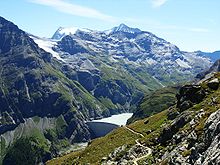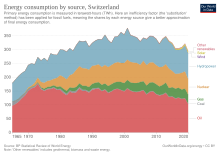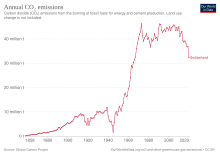
Back الطاقة في سويسرا Arabic Energia a Suïssa Catalan Schweizer Energiepolitik German Énergie en Suisse French Energi di Swiss ID İsviçre'de enerji Turkish


This article needs to be updated. (February 2024) |
Energy in Switzerland is transitioning towards sustainability, targeting net zero emissions by 2050 and a 50% reduction in greenhouse gas emissions by 2030.[1][2]
Switzerland's energy relies mainly on petroleum, nuclear, hydroelectric, and natural gas, with approximately 70% of its consumption imported, primarily from non-renewable sources. Launched in 2011, the 2050 Energy Strategy aims to shift towards sustainable energy practices, achieving climate neutrality and reducing reliance on fossil fuels.[3]
Energy consumption per capita in Switzerland has shown a steady decline over the years. Despite a notable population increase of 28.7% between 1990 and 2020, energy consumption decreased by 5.9% during this period. The majority of energy consumed in Switzerland is derived from petroleum and motor fuels, accounting for 43% of the total, followed by electricity at 26%, and gas at 15%. Private households and transport sectors utilize the most energy, each contributing one third, while manufacturing and services sectors each account for just under one fifth of the energy consumption.[4]

After the Fukushima Daiichi accident in March 2011, Switzerland took significant steps regarding its nuclear energy policy. The Federal Council suspended pending procedures for new nuclear power plant licenses, and in the same year, both the Federal Council and Parliament decided to phase out nuclear energy gradually. This decision laid the groundwork for the 2050 Energy Strategy, which involves decommissioning Switzerland's five nuclear power plants as they reach the end of their operational lives, with no plans for new replacements.[5] The country plans to phase out nuclear power plants by 2044.[6]
In 2017, the Swiss public voted in favor of the revised Energy Act, marking the initial implementation of the 2050 Energy Strategy. Subsequently, in June 2023, the Swiss public voted in favor of the Federal Act on Climate Protection Goals, Innovation, and Strengthening Energy Security (Climate and Innovation Act). This legislation establishes a framework for Swiss climate policy, setting interim targets for reducing greenhouse gas emissions by 2050.[7]
The Mantelerlass, passed by the Swiss parliament on September 29, 2023, aims to accelerate renewable energy development. It sets a target of 35 TWh/year from new green technologies by 2035, compared to around 6 TWh/year in 2022. This would cover about half of Switzerland's expected electricity demand in 2035, with the rest to be met by hydroelectric power and imports.[8]
- ^ "Switzerland 2023 – Analysis". IEA. Retrieved 2024-02-15.
- ^ "Switzerland 2023 Energy Policy Review" (PDF). International Energy Agency.
- ^ "Energy". www.eda.admin.ch. Retrieved 2024-02-15.
- ^ "Energy – Facts and Figures". www.eda.admin.ch. Retrieved 2024-02-14.
- ^ "Switzerland 2018". www-pub.iaea.org. Retrieved 2024-02-15.
- ^ Cite error: The named reference
mck135was invoked but never defined (see the help page). - ^ Energy Strategy 2050. Swiss Federal Department of the Environment, Transport, Energy and Communications DETEC. Retrieved 2020-01-11.
- ^ "Three strategies to boost green electricity in Switzerland - Medias - UNIGE". www.unige.ch. 2024-01-10. Retrieved 2024-02-17.
© MMXXIII Rich X Search. We shall prevail. All rights reserved. Rich X Search